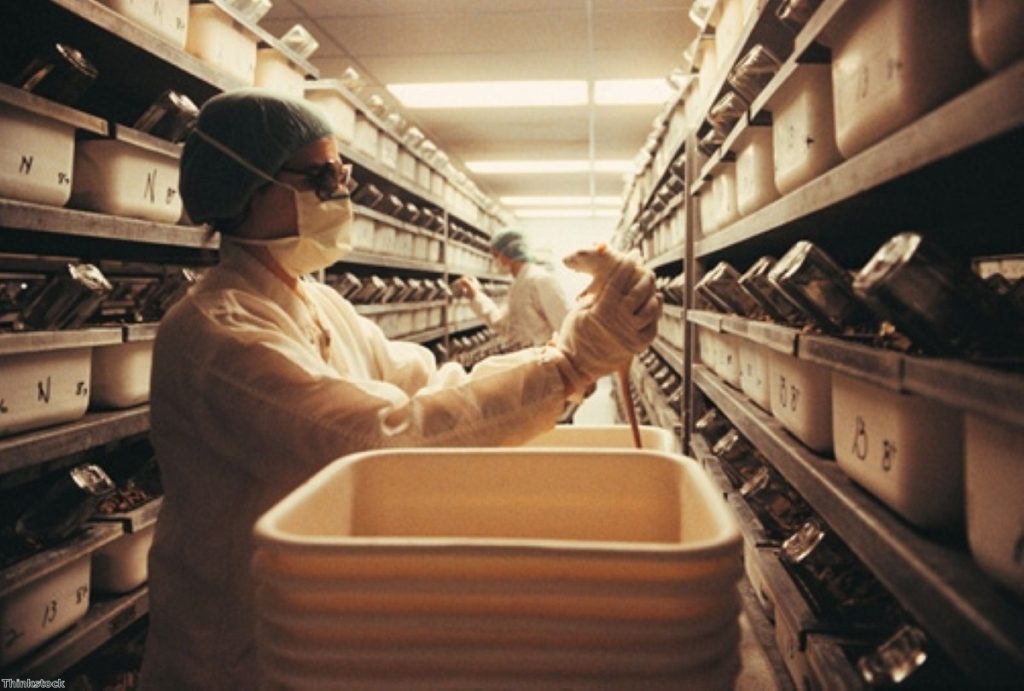Comment: The perverse growth of animal experiments
By Mimi Bekhechi
Most of us would be reluctant to use a phone, computer, television or camera from 30 years ago. Technology has made them obsolete. So why are UK scientists still conducting antiquated experiments on animals that have, for decades, proved ineffective, while modern non-animal testing methods have advanced by leaps and bounds?
Last week the government released its annual statistics report on scientific procedures on living animals. The numbers are disturbing. We are seeing the highest number of experiments conducted on animals in a generation. In 2013, 4.02 million animals were used; a staggering 52% increase since 2000.
What the statistics don't show is the suffering that thousands of animals endure in UK laboratories every day. The abuse inflicted on these animals would be illegal if it took place in any other context. They are starved and dehydrated in order to make them willing to cooperate with experimenters in exchange for a morsel of food or a sip of water. They are poisoned, cut open, blinded, electrocuted and infected with deadly diseases. At the end of the experiments, they are killed.


In addition to the abuses that take place as a normal part of an experiment's protocol, the government's annual report noted at least 34 cases of non-compliance or failure to meet even the bare minimum standards of animal care set forth in the Animals (Scientific Procedures) Act 1986. At one institute alone, five cases of neglect and incompetence were confirmed involving eight individuals. It was concluded that there was a poor culture of care at this institute and the continued role of the establishment licence holder has been called into question. At other establishments procedures were carried out without the appropriate authority, more animals were used than authorised, mistakes were made which resulted in the death of animals and far more animals died than experimenters had predicted. In addition to these atrocities, failure to maintain an air conditioning unit at a breeding establishment led to the unacceptable death of 787 rats and 345 mice.
Although animals have the same capacity to feel fear and pain that humans have, our physiology is vastly different. And that is why animal experiments fail.
Aspirin can kill cats and cause birth defects in rats, mice, guinea pigs, dogs and monkeys. Morphine, a depressant in humans, stimulates goats, cats and horses. With vast differences in the physiology of different species and poorly conducted experiments, it comes as no surprise that 92% of all drugs that are shown to be safe and effective in animal tests prove to be ineffective or even dangerous to humans. Richard Klausner, the former head of the US National Cancer Institute, has admitted: "The history of cancer research has been a history of curing cancer in the mouse. We have cured mice of cancer for decades – and it simply didn't work in humans".
Forward-thinking scientists, many with funding from PETA and its international affiliates, are developing methods for studying diseases and testing products that don't require the use of animals and are actually relevant to human health. New ' contain lab-grown human cells which mimic the structure and function of human organs. MatTek's EpiDermTM Tissue Model, a 3-dimensional, human cell–derived skin model, replicates key traits of normal human skin.
Researchers at the European Union Reference Laboratory for alternatives to animal testing developed five different tests that use human blood cells to detect contaminants in drugs that cause a potentially dangerous fever response. And researchers have developed a wide range of sophisticated computer models that simulate human biology and the progression of developing diseases. Studies show that these models can accurately predict the ways that new drugs will react in the human body and replace the use of animals in exploratory research and many standard drug tests.
It's no wonder that so many people are ready to end the use of animals in experiments. A recent Ipsos MORI poll commissioned by the Department for Business, Innovation & Skills has shown that 76% of Britons want to see more research into alternatives to animal testing. More than a third say that they are opposed to the use of animals in any experiment because of the importance that they place on animal welfare. That number increases to nearly half in the younger generation, aged 15 to 24. A full 64% of adults are concerned that scientists are conducting unlicensed experiments on animals, and more than half do not trust scientists not to cause animals unnecessary suffering.
Yet of the £300 million in government funding for biosciences, only one per cent is directed towards replacing animals in experiments.
But there is a light at the end of this long, dark tunnel. Following a continued campaign, including help from thousands of PETA supporters, the coalition government has begun a review of Section 24 – the confidentiality clause – of the Animals (Scientific Procedures) Act 1986. Section 24 provides animal experimenters with a cloak of secrecy. But the government has acknowledged that the clause is incompatible with the public's right to access information, as granted by the Freedom of Information Act 2000. And the government has affirmed that Section 24 must be replaced or amended.
This is a big step in the right direction. Only by pulling back the veil of secrecy, informing citizens of the atrocities that their tax money is funding and holding experimenters accountable for abusing animals in the name of science when more reliable, cruelty-free options exist, can we hope to bring scientific research into the modern age.
Mimi Bekhechi is the associate director of the People for the Ethical Treatment of Animals Foundation (Peta)
The opinions in politics.co.uk's Comment and Analysis section are those of the author and are no reflection of the views of the website or its owners.












